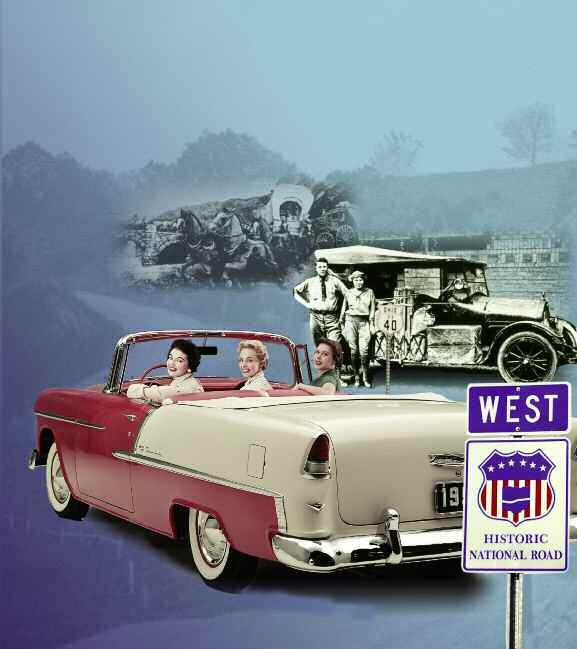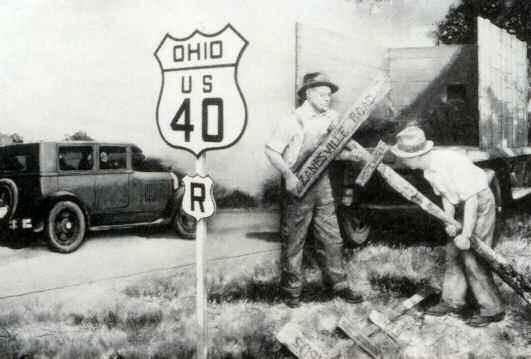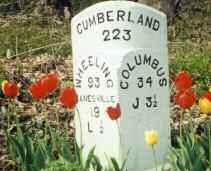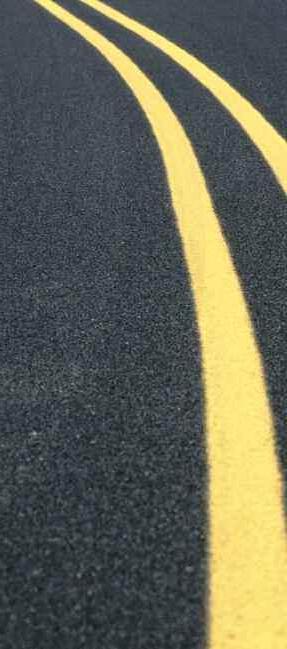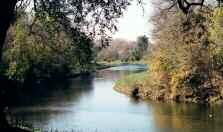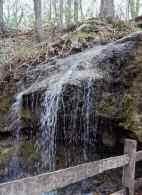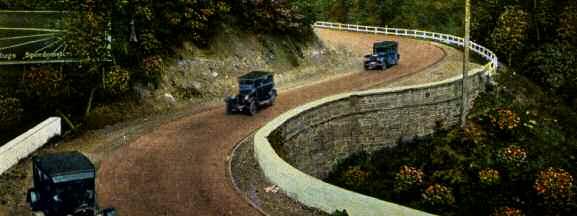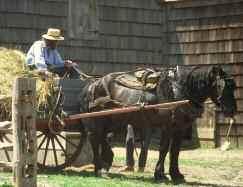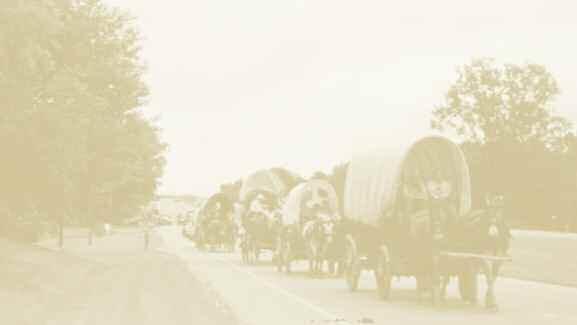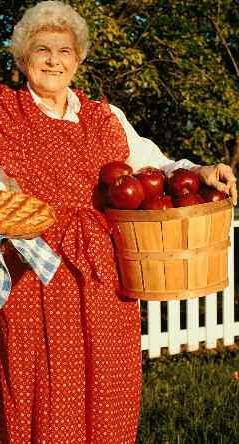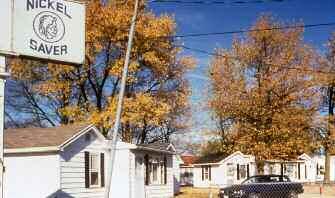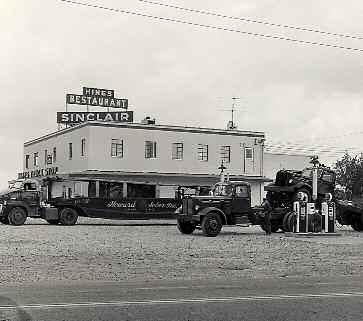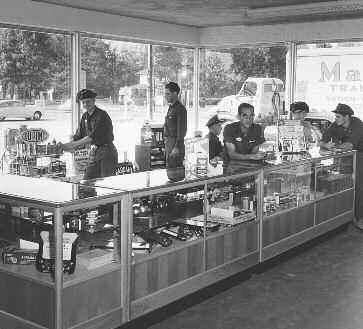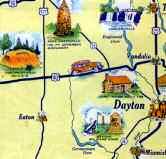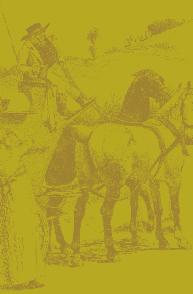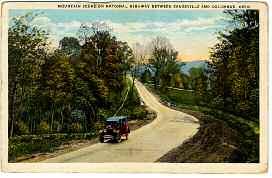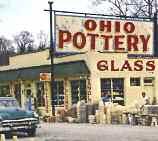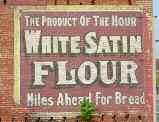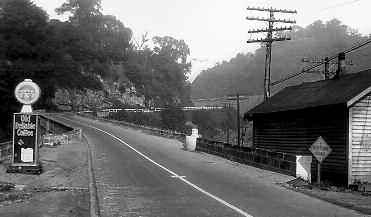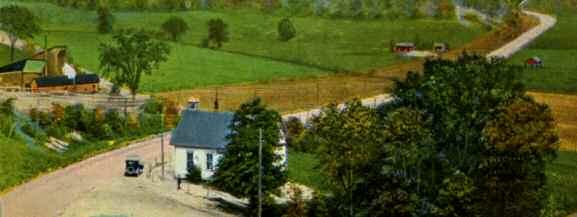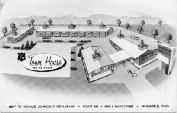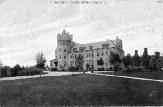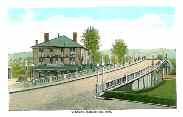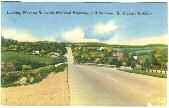Recreation Parks and Natural Areas
Atremendous network of state and regional MetroParks, local parks and privately run facilities offer an abundance of outdoor recreational opportunities, including hiking, biking, camping, fishing, hunting and picnicking. Over 50,000 acres of state parks, forests and wildlife areas are easily accessible from the National Road. Visitors can also experience local flora and fauna in a wide variety of settings. The Columbus MetroParks and Five Rivers MetroParks in Montgomery County, offer additional opportunities to explore the area ’ s natural beauty. Over 9000 acres of local parkland are accessible from the byway. Several regional recreational (hike and bike) trails are located in the Dayton area.
Privately-run facilities add to the selection of recreational opportunities. The facilities which lie in close proximity to the byway include The Wilds in Muskingum County, Dawes Arboretum in Licking County and Aullwood Audubon Center and Farm in Montgomery County.


9
From Wheeling, West Virginia, cross the Wheeling Suspension Bridge, 1849, a National Historic Landmark. Turn right (north) onto York Street for three blocks. Then go left (west) on Zane Street one block. Follow the U.S. 40 West signs at Madison School and cross into Bridgeport. Here the National Road intersects with State Route 7, part of the Ohio River Scenic Byway, another National Scenic Byway.
Bridgeport
Bridgeport was originally a trans-shipment point for goods going down the Ohio River from Zane’s Trace. Later it was a Pike town. Bridgeport’s later growth and decline were dictated by the growth and subsequent decline of the railroad and mining industries. Today, a suburban strip blurs the boundaries between Bridgeport and the small communities of Wolfhurst, Brookside, Lansing and Blaine, to the west.
● 1 Gateway Sign
Brookside
● 2 Spanish Revival Service Station
879 National Road
A 1930s Pennzoil Station typical of service stations along early U.S. 40.
Blaine Vicinity
● 3 The McGonigal Tourist Home
53789 National Road
Edward and Mary McGonigal operated a tourist home in this ca. 1900 house during the 1920s and 1930s. A curbside gas pump stood beside the stone wall. In an age before large motels, numerous cabin camps and tourist homes lined U.S. 40.
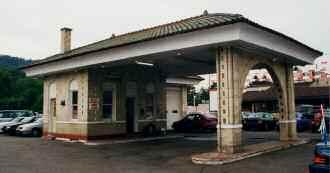
● 4 The Blaine Hill Viaduct
Built in 1932–1933, the Blaine Hill Viaduct overshadows the 1828 stone bridge, which could no longer handle the increasing automobile traffic. Named the Arches of Memory bridge, it was dedicated to the memory of the World War I veterans of Belmont County. When I-70 was opened above it in 1964, major traffic flow was diverted from this bridge. The Blaine Hill Viaduct now forms the middle portion of a site encompassing three generations of transportation history.
● 5 Old Road Segment
A 1918 brick paved section of Road (now Pasco Drive), can be seen here. A unique mile marker identifies the entrance to Pasco Drive.
● ● 6 The Blaine Hill “S” Bridge
At the western edge of Blaine, just before you start up the Blaine Hill Viaduct, veer to the right and drive across an old brick segment of the Road about 100 yards west to the famous Blaine Hill “S” Bridge. Constructed in 1828, it is the oldest documented standing bridge in Ohio. The Blaine Hill “S” Bridge is 385 feet in length, with three segmental arches, spanning Wheeling Creek, a tributary of the Ohio River. The bridge is straight but the approaches are curved creating an “S” plan. At a gradual
10 40 70 3 4 5 7 6 9 8 1 2 12 13 11 14 16 17 18 20 10 15 19 Brookside Lloydsville Blaine Bridgeport St. Clairsville Morristown 01234 Miles oihO R i v e r W V a
Belmont County
Bridgeport to Morristown
Spanish Revival Service Station, Brookside.
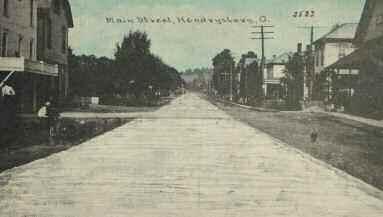

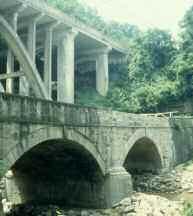
Old Road Segments
The National Road and later U.S. 40 were never just one unchanging alignment or right of way. Instead it seems to have morphed over time as bridges were replaced, Main Streets were modernized, paving was updated and road building technology was improved. These changes have resulted in numerous bypassed or abandoned segments of original roadbed. This is especially true in eastern Ohio where the hilly terrain and sharp turns demanded road improvements. These old Road segments can often be identified by their red bricks that were added to improve the Road surface for military transport during World War I.
Clockwise from top:
Main Street (National Road) with freshly laid planks in Hendrysburg
Contemporary photo of old brick segment
Two early 1900s modes of transportation on new concrete segment of Road between Zanesville and Hebron.
Repairs to arch of Blaine Hill “S” Bridge, with Arches of Memory Bridge in background.
Blaine Hill “S” Bridge, 1920s.
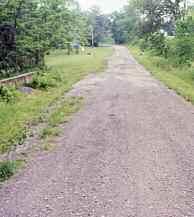
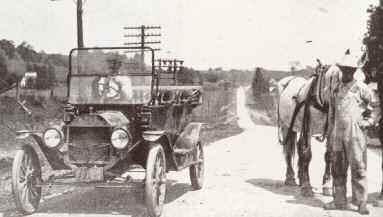
11
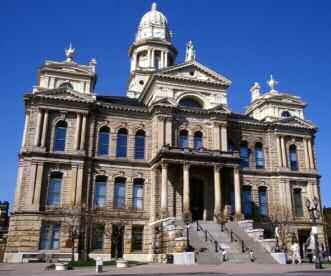
grade of 6.3 percent from east to west, it significantly eased the arduous 500-foot climb out of the valley. Retired from highway use in 1933, it was saved from demolition in 1999 and has since been restored and was listed on the National Register of Historic Places in 2010. Tucked beneath I-70 and the Blaine Hill Viaduct, it is the anchor location in illustrating the evolution of transportation in Ohio and the nation.
In 2001, the Ohio Legislature officially designated the Blaine Hill Bridge Ohio’s Bicentennial Bridge. The bridge was restored and rededicated in 2005.
● 7 “Big Hill”
The so-called “Big Hill” west of Blaine was one of the most dangerous stretches of the National Road and later U S 40 One folk account recalled over 20 curves, each with its own name
● 8 Hillside Motel and Plaza Motel
Two well-maintained examples of 1950s family-owned roadside motels, each still open 24 hours a day, and each of which has flourished and survived to this day.
St. Clairsville Vicinity
● 9 Ebbert Farm Market
South side of the Road at Ebbert Road (between I-70 exits 218 and 220).
Dominated by an 1864 Italianate farmhouse, this site is typical of the prosperous farms that once had fruit stands along the Road. It remains a working farm.
St. Clairsville
● 10 National Register Historic District
Follow U.S. 40 to downtown St. Clairsville, the county seat of Belmont. Originally known as Newelstown, it was platted in 1803, over two decades before the arrival of the National Road. The St. Clairsville Historic District (East and West Main Streets between Butler and Sugar Streets) is listed on the National Register of Historic Places
A walking tour brochure of the St. Clairsville Historic District is available at City Hall, located at Main Street and North Market Streets.
● 11 The Boroff House
191-193 East Main Street
An 1830s Federal double house at the top of “Greasy Hill,” a treacherous stretch of road that turned muddy during rainy weather
● 12 Benjamin Lundy House
164 East Main Street
A pre-1815 three-bay “I” house with nicely carved sandstone lintels. This was the home of Benjamin Lundy, an early abolitionist and St Clairsville’s most famous citizen
● 13 Belmont County Courthouse
Constructed in 1885 in the Beaux Arts style by Columbus architect Joseph Warren Yost. Note the old jail and sheriff ’ s residence next door and the restored mile marker indicating 63 miles to Zanesville
● 14 Clarendon Hotel
Across the street from the courthouse, at 100 East Main Street is the 1889 Clarendon Hotel built on the site of an earlier National Road tavern.
●
15 Lighthouse Inn
● 16 Old Road Segment
On the south side of the Road just west of town is a well-preserved bypassed (bricked) segment of original roadbed. The curve and steeper incline were eliminated when the Road was upgraded in the 1920s
Continue west on U S 40
● 17 Vine Yard School
At the intersection of Belmont County Road 59, is the Vine Yard school constructed in 1867. The school building has also been used as a church and a town hall. The building now houses a business.
● 18 Twin Pines Motel
At the intersection of State Route 331 is the Twin Pines Motel, 46079 National Road, a rare example of an L-shaped 1940s brick “motor court.”
● 19 Great Western Schoolhouse
On the north side of the Road, just west of Ohio University is the one-room Great Western Schoolhouse. This charming brick building was constructed in 1870 and was named for the proposed community of Great Western The town, which was never built, was platted on land across from the school
12
Belmont County Courthouse, 1990s
● 20 Brick Tavern/Lentz Tavern
On a rise next door to the school is the brick tavern known as Lentz Tavern. This large brick structure once featured a twostory porch, and a large wooden awning or “stand” for sheltering wagons. Originally, travelers could pull up in front of the inn When the National Road was upgraded, a cut was made to level the Road, leaving the tavern standing high above. Now owned by Ohio University, the building will soon undergo restoration
Lloydsville
A short distance west of the Brick Tavern, the old National Road diverges to the left (south) and into Lloydsville, another Pike town. Just after leaving U.S. 40, you will cross a stone bridge. Just past the bridge, on the left, watch for the old wooden posts and steel cable, a predecessor to the guard rails of today Continue through town, turn left and return to U S 40, passing the Jamboree in the Hills site, a venue for one of the region’s largest country music festivals.
1 1/2 miles after Lloydsville, watch for Twp. Rd. 814, “Old U.S. 40E”, on the north side of U S 40, a short distance before S R 149 Turn right (north) and then immediately left (west), where you will travel a short, bypassed segment that runs parallel to 40. At the bottom of a small hill you’ll come to a stone bridge that crosses Barkcamp Creek. Here is also a long, concrete box culvert under the 1930s realignment of U S 40 Continue westward back to U.S. 40 and turn right (west).
The Legend of Lady Bend Hill
Local lore has it that in 1833 a young lady from a wealthy Wheeling family, who had been courting a younger man of lesser means from Fairview, stole away in the night from her parents’ home in a coach with a particularly energetic horse. She headed for the Guernsey County town to steal away with her lover. On the third bend from the top of this hill west of Morristown, a sudden bolt of lightning spooked the horse, forcing the coach to slide and ejecting the young lady from it, breaking her neck. Afterward, the horse ran aimlessly around for three days until it was finally corraled. It is said that even today on very stormy nights, the apparition of a headless young lady astride a spirited steed can be seen riding recklessly up and down the hill.
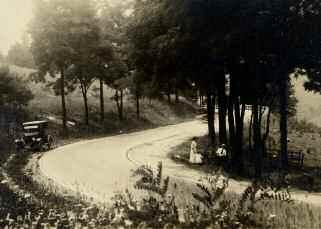
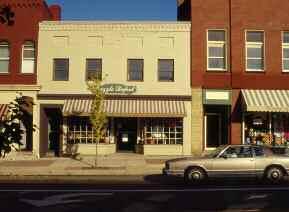

13
Above: Lady Bend Hill, National Road, 1920s
Below: (left) U.S. 40, St. Clairsville, 2000 (right) National Road, St. Clairsville, 1920s.
Morristown to Cambridge
Just west of S.R. 149, bear right (north) onto the old National Road to Morristown.
Morristown
● 1 National Register Historic District
Church Street, one block north, actually pre-dates the National Road and was part of Zane’s Trace. Morristown was surveyed and platted by John Zane and William Chapline in 1802. It was named for Duncan Morris, an early tavern keeper and justice of the peace. Morristown was a major stagecoach stop and prospered during the heyday of the National Road, with approximately fifty businesses, including blacksmiths, saddlers, wagon-makers, grocers and hotel operators. Morristown began to decline after 1850 when it was bypassed by the railroad Today it remains a classic Pike town with numerous brick and frame row-houses typical of eastern cities such as Baltimore and Philadelphia. Of particular note is the Black Horse Inn, ca. 1807, located at West and Cross Street and the National Road.
A walking tour brochure of the historic district is available online at www.morristownohio.com.
● 2 Egypt Valley Wildlife Area
This 14,300-acre public hunting and fishing area is managed by the Ohio Department of Natural Resources. Its southern boundary lies along U.S. 40 between Morristown and the Guernsey County Line.
Leaving Morristown, follow U.S. 40 west until it dead-ends at Stillwater Creek, approximately 2 5 miles west of town Turn left (south) onto the I-70 westbound ramp, and continue to the next exit, #202, proceeding off the interstate to S.R. 800. Turn left (south) onto S R 800, crossing I-70 and go just beyond the eastbound on-ramp of the interstate. Turn left (east) just past the ramp, onto Belmont County Road 102. Just a few hundred feet down this former four lane segment of U S 40 alignment, you can see to the north a relic brick segment of the National Road that terminates at a private residence.
Within 200 feet of this location, it is possible to view the original Road, a partially abandoned segment of U.S. 40 and I-70. Travel a little farther east on the county road and you can see how I-70 was overlaid onto U.S. 40.
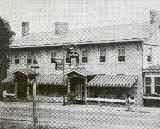
Return to S.R. 800, cross I-70 and pass the on ramp, continuing to the left (west) on S.R. 800 to Township Rd. 108, turn right (north) and proceed into Hendrysburg.
Hendrysburg
Founded in 1828, Hendrysburg is the birthplace of William Boyd (Hopalong Cassidy), famous for his westerns
Here is another good location from which to view three generations of road building, the old National Road, U.S. 40 and Interstate 70.
● 3 Clark House
66539 Freeport (old National Road)
An 1828 brick residence that once served as a drover’s tavern and still has outbuildings and a roadside well.
● 4 Old Road Segment
On the north side at Kirkwood Township Road (deadends in a private drive) is a bricked old Road segment.
Left: Black Horse Inn, Morristown, 1930s. This postcard with a November 14, 1930 postmark from Morristown, had a note which began, “Dear Mother, Arrived at this pretty little inn about twelve ”
14 40 70 77 4 3 2 1 5 7 9 10 11 12 13 14 15 6 8 Cambridge Morristown Cassell Fairdale Hendrysburg Lloydsville Middlebourne Craig Fairview OldWashington 01234 Miles
Belmont County/Guernsey County
Pike Towns and the Main Street Model
Many of the Pike towns traditionally associated with the National Road’s early period were actually founded in the first two decades of the nineteenth century, before the National Road was constructed or even surveyed. Some communities such as Zanesville, platted in 1797, Morristown in 1802, St. Clairsville, 1803 and Old Washington, 1805, were actually laid out along the earlier Zane’s Trace. A higher percentage of Pike towns in western Ohio date their founding to the Road’s construction in the 1830s. Town development along the National Road was dominated by the Main Street model, a linear plan including a principal street and one or two parallel “back streets.” Main Street, the National Road, was the town’s commercial and residential center, while the back streets were used by teamsters and drovers. As towns grew, churches and schools were also built along these back streets.
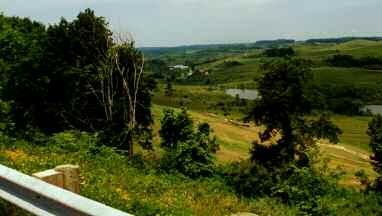
A Landscape Changed
Western Belmont and eastern Guernsey counties reflect a landscape fundamentally changed by the ravages of strip mining and reclamation. The formerly steep-forested hillsides were stripped of their trees and the land re-contoured after the coal was removed. Today, these areas consist of grasslands and scrub trees and are primarily used for grazing.
Continuing west on S.R. 800, you’ll ascend what is known locally as “Seven Gables Hill”, named after the landmark, multi-gabled structure situated about 1 1/2 miles west of Hendrysburg where 800 bears to the right (north) and the Old National Road (County Road 40A) diverges to the left (west). Continue westward into Fairview.

GUERNSEY COUNTY
A detailed driving tour of Historic National Road sites in Guernsey County is available from the Cambridge/Guernsey County Visitors and Convention Bureau, 800-933-5480 or www.visitguernseycounty.com, and at the Fairview Post Office, open Mon.– Sat., 9:00 am – 6:00 pm.
Fairview
Off I-70 W, Exit 198. Fairview began to prosper when the National Road entered eastern Guernsey County in 1827. Evidence of this prosperity can be found along Fair Avenue, the old National Road and the
town’s main street, where several large historic houses representing distinctive nineteenth century architectural styles, are located. Fairview boasted a pennyroyal distillery. Pennyroyal herb oil was valued for its medicinal uses.
● 5 Pennyroyal Opera House 1830, now houses Bluegrass Concerts.
Return to I-70, turn right onto the westbound ramp, and continue west to the next ramp at exit 193, turn right (north) onto S R 513, then immediately left (west) onto County Road 690 (Bridgewater Rd ) You’re back on the old National Road
Middlebourne
A small Pike town and the former site of Hays Tavern, later known as Locust Lodge, built in c. 1830 by Thomas Hays. Henry Clay occasionally stayed here on his way from his home in Kentucky to Washington D.C.
15
National Road (Fair Avenue) in Fairview, Ohio, 1990s.
● 6 Salt Fork S-Bridge NATIONAL HISTORIC LANDMARK
Veer right (north) onto County Road 6794 (Bridgewater and Blend Road) and cross Salt Fork over the S-bridge.
This is one of two “S” Bridges in Guernsey County (the other one is at U.S. 40 and Peters Creek Road, west of Cambridge). This rural setting appears much as it did in the heyday of wagon and stagecoach travel. Salt Fork S-Bridge is a good place to examine this early engineering technique of aligning a bridge to cross a stream at a structurally sound 90 degrees. (See S Stands for Bridge, page 41 ) It is also one of the few spots along the way to view the National Road, U.S. 40, Zane’s Trace, and I-70, particularly from late autumn to early spring Drive over the bridge as countless wagons, buggies and Model-T’s have done before you.
Return to County Rd 690 (west) by turning right after the bridge. Turn left (south) onto County Rd 75, (Frankfort Road) crossing under I-70, then immediately turn right (west) onto County Road 670 (Easton Road).
● 7 Creighton House
16985 Easton Road at Elizabethtown
Though altered over the years, Creighton House is one of the few surviving wagon and drover-stands
Turn right (north) onto County Home Road, crossing over I-70
Old Washington
● 8 National Register Historic District
Turn right (east) onto Fairground Road, then left (west) onto Old National Pike into Old Washington.
Originally known as New Washington, the name was later changed after it was discovered that an Ohio town of the same name already existed. Platted in 1805 by brothers George and Henry Beymer on the old Zane’s Trace, Old Washington grew rapidly after the National Road was built over the earlier route, reaching its zenith in 1850.
● 9 130, 220 and 225 East Main Street
Prosperous residents built these Italianatestyle houses. Near the intersection with State Route 285 are several examples of earlier Federal-style architecture.

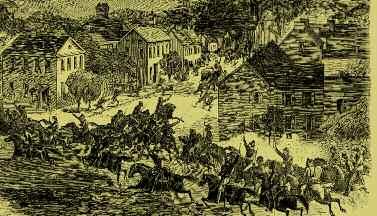
An Old Washington walking tour brochure and Guernsey County Historic National Road brochure are available at Cochran’s Market.
Turn right (west) on U.S. 40 west
● 10 Deep Cut
The National Road cuts through a hill called Deep Cut, located west of the Deep Cut Tavern. Initial excavations were completed when the Road was constructed with more extensive cutting through the hill about 1940
● 11 Old Road Segment
About 1 mile west of Old Washington on the left (south) side of U S 40 is Arrowhead Road Turn left (south), then right (west) onto a relict segment of the National Road, which dead ends at a private residence
● 12 Hyde Hill Tavern
13442 Wardeska Lane (U.S. 40 west across from Hidden Acres sign)
West of Old Washington and south of the Road is an old Road segment now known as Wardeska Lane. The Federal-Style house (private residence) located here is known as Hyde Hill Tavern or Shaw Tavern. It is located at a strategic point on the Road also known as Serpentine Hill. During Morgan’s Raid, General John Hunt Morgan, anticipating an attack, placed two pickets at the Tavern, resulting in the Hyde Hill skirmish, July 24, 1863
Old Washington Invaded
During the Civil War, on July 24, 1863, John Hunt Morgan and his Confederate Cavalry, known as Morgan’s Raiders, paused here and scattered throughout the village looking for food. They stopped at The American Hotel (demolished) and while dining, were attacked by pursuing Union forces. This was the only Civil War skirmish on the National Road in Ohio. The town cemetery overlooks the village below. A Civil War Marker, “Morgan’s Raid in Old Washington,” stands near the area where three Confederate soldiers are interred. It is interesting to note that this skirmish took place during the same month and year as the Battle of Gettysburg in Pennsylvania.
16
The former Colonial Inn in Old Washington
● 13 Peacock Road (Center Township Road 650)
Approximately four miles west of Old Washington turn left (south) opposite Sundew Road onto this 6/10 of a mile old Road segment. The Road is part of the original 1828 right-of-way and still serves as an access road for two farmsteads and the former Center Township Hall. Like other old Road segments, Peacock Road exemplifies the early National Road characteristic of following, not avoiding or eliminating, the rough, hilly terrain of eastern Ohio. Here the Road crests atop a high ridge, skirts a forest, descends a steep hill to round a sharp curve and then follows a narrow valley to ascend a hill again. The brick paving laid in 1918 (see Brick Road Segments), originally measured sixteen feet across with six inch concrete curbing on either side. Where the Road descends a hill, a concave shaped brick curb is built inside the concrete curb An Ohio Department of Transportation engineer believes the curb was built to reduce traffic dangers due to the steep grade and sharp curve Running parallel to the curb for three hundred feet on the south side of the Road is an early type of guardrail. First used by ODOT in 1925, it consists of cable or wire rope, wood rail and wood posts
Return to U.S. 40 (west) and travel one-fourth mile. Turn right onto the old National Road.
Craig
Small Pike town on this curvy section of Old National Road.
● 14 Four Mile Hill/Serpentine Hill
This old Road segment is actually part of the earlier Zane’s Trace. It was designed in a serpentine shape to lessen the incline for horses pulling heavy loads Miners’ early homes and a small pond, the result of a strip mine pit, can be seen on this stretch of Old National Road.
● 15 Cooks Run Stone Bridge
U.S. 40 and Cooks Run Road
Named for Captain Thomas Cook, who served in the Revolutionary War.
Continue west back onto U.S. 40. Follow U.S. 40 west into Cambridge (where it becomes Wheeling Avenue), eventually crossing over the railroad and Wills Creek.
Brick Road Segments
In 1918, the Federal government concluded that in order to win World War I, more supplies were needed overseas. After investigating various alternatives, the National Road was chosen as the best means of transporting goods overland. However, before the Road could accommodate the heavily loaded trucks it had to be improved. Using convict labor, the government paved over 75 miles of the National Road in eastern Ohio with brick, creating the longest continuous stretch of brick pavement in America. Approximately 22 relic portions of the National Road with brick pavement have been documented.
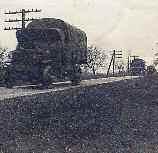
Top: A WWI U.S. Army convoy passes by on the Road Bottom: Old Road Segment, Peacock Road, Guernsey County

17
Cambridge to Zanesville
Cambridge
● 1 National Register Historic District
Cambridge was platted in 1806 and became the Guernsey County seat three years later. By 1834, the town was served by four daily stagecoach lines. Coal mining contributed to the growth of the county, and by the 1880s, Cambridge was a crossroads of the B&O and the Cleveland and Marietta Railroads.
● 2 Guernsey County Courthouse
The 1883 courthouse was designed by Columbus architect J.W. Yost who also designed the Belmont County courthouse. It is a fine example of the Second Empire style. The dominant architectural styles of the late nineteenth and early twentieth centuries are reflected in the Italianate Broom Building, 701 Wheeling Avenue, 834 Wheeling, the Richardsonian Romanesque Rech Building, 626 Wheeling, the 1904 Classical Revival Carnegie Library, 800 Steubenville Avenue and Post Office, 954 Wheeling For decades Cambridge’s major industry was glassmaking, a heritage commemorated in the Cambridge Glass Museum, 812 Jefferson Avenue and the National Museum of Cambridge Glass, 136 South 9th Street.
● 3 Viaduct 5th and Wheeling Avenue
The first bridge authorized by the legislature of the Northwest Territory, was built of logs at this site to span Wills Creek in 1801 A covered bridge was constructed in 1828 when the National Road was built. The covered bridge was replaced in 1925 by a viaduct which was in turn replaced in the 1960s.
A walking tour brochure of historic Cambridge is available from the Cambridge/Guernsey County Visitors & Convention Bureau, 627 Wheeling Avenue, 800-933-5480.
After crossing the viaduct turn right (west) on U S 40
● 4 Stone bridge
After skirting the bluff that was cut through by U.S. 40, the old Road crossed Crooked Creek on a straight stone bridge.
Continue west on U.S. 40 to Fairdale Road. Turn right (north) into Fairdale.
Fairdale
A long, narrow Pike town with a short, brick-paved segment at its eastern edge.
● 5 Fairdale Toll House
5988
Fairdale Road
A toll house was constructed at this site as a means of financing maintenance of the Road after it was turned over to the state and ultimately to local control. The building has been altered over the years.
Turn right to return to U.S. 40 west
● 6 Peters Creek S-Bridge
Don’t miss this 1828 stone bridge on the north side of U.S. 40 west of Cambridge at Peters Creek Road. (See S Stands for Bridge, page 41.) This bridge was restored in 2007.
● 7 Oliver Barnett House
2781 Best Hill Road
This old Road segment includes the c. 1870s Italianate-style home of Civil War veteran Oliver Barnett. Stone and lumber for the home were quarried and harvested from the property
● 8 Devils’s Dip
A mile and a half east of New Concord is an inaccessible old Road segment known as Devil’s Dip because of the steep hill, curve and narrow bridge early motorists were required to negotiate
18 14 40 70 77 2 3 4 5 7 8 11 12 9 6 13 1 15 18 17 20 21 23 24 22 19 Zanesville Cambridg e Norwich Cassell Fairdale New Concord 16 10 0 1234 Miles
County/Muskingum County
Guernsey
Tolls, Toll Houses and Road Maintenance
After 1838, the Federal government no longer appropriated funds for National Road maintenance, though maintenance of the Road had actually been relegated to the states earlier in the decade. To pay for maintenance, Ohio and other states began collecting tolls. Even before construction was completed, the Road had in effect become an Ohio turnpike. Toll taking locations (toll houses) were constructed about every twenty miles along the Road and tolls were determined by the type of vehicle. According to a list of tolls from 1832, the highest tolls were for cattle and two-horse carriages. Wagons with wheels in excess of six inches in width were exempt from tolls, presumably because larger wheels were actually beneficial in compacting Road gravel. Exemptions were also made for persons traveling to and from church, funerals and places of business. Clergymen and children were also exempt. In contrast to the substantial brick and stone octagonal toll houses in Maryland and Pennsylvania, Ohio toll houses were generally frame side-gable structures with a recessed corner porch. Despite the $1.25 million in tolls collected between 1831 and 1877, the Ohio National Road languished in a deplorable condition. Tolls remained in effect in some areas until 1910.
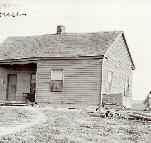
● 9 McDonald House
U S 40 and Morgan Road
The William McDonald family owned this stagecoach stop and the Fountain Pump Tavern that was located west of the building across Morgan Road. McDonald was awarded a contract to build a one-mile segment of the National Road through Cambridge.
Follow U.S. 40 west to New Concord.
MUSKINGUM COUNTY
A heavily vegetated landscape encloses views along much of the Road in Muskingum County. Topographic features are typical of the un-glaciated landscape of eastern Ohio, often affording long views from ridgelines.
A brochure highlighting National Road historical and commercial sites in
Muskingum County is available from the Zanesville-Muskingum County Convention and Visitors Bureau, 800-743-2303, www.visitzanesville.com
New Concord
New Concord was platted in 1828, while the National Road was under construction, but its prosperity was quickly linked to Muskingum College, founded in 1837 by Presbyterian denominations.
● 10 William Rainey Harper Log House
Opposite the entrance to the College is the 1834 log house where William Rainey Harper was born in 1856 Harper went on to become the first President of the University of Chicago

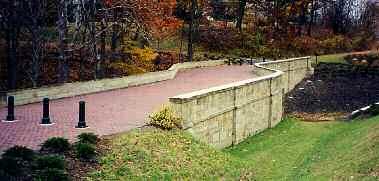
19
Two views of Fox Run S-Bridge, New Concord. Top: 1920s. Bottom: Restored bridge (now S-Bridge Park, 2000) For more information on S-Bridges, see page 41.
National Road toll house in Clark County.
● 11 Muskingum College, Paul Hall
Walk or drive a block north to Muskingum College’s main entrance to see Paul Hall, the oldest surviving building on campus. This handsome Victorian Italianate building with its round arch windows and doors is quite typical of the "Old Mains" that served many private nineteenth century liberal arts colleges.
● 12 John and Annie Glenn Historic Site
72 West Main Street
Housed in John Glenn’s boyhood home and new addition, the John and Annie Glenn Historic Site interprets the lives of the famous astronaut and his wife and relates the story of the twentieth century through the prism of their experiences during the Great Depression and on the home front during World War II. Additional programming and exhibits deal with the Cold War, the Space Race and social issues arising out of the end of the War An exploration center is planned for the site in the future.
● 13 Fox Run S-Bridge (S-Bridge Park)
Just west of town on the north side of the Road is the Fox Run S-bridge. The bridge and short segment of old Road were abandoned when U.S. 40 was realigned in the 1930s The bridge was restored in 2000 and is now part of a small park with parking, a walkway and interpretive panels. A sign

points the way to the home of Robert Spears, a stop on the Underground Railroad. (See S Stands for Bridge, page 41.)
Turn right (north) on Norwich Road /Drive continuing west to Main Street in Norwich
Norwich
● 14 The First Fatal Traffic Accident
A small memorial on the north side of Norwich Road, at the eastern end of the village commemorates the first fatal traffic accident in Ohio. A westbound stagecoach rounded a sharp curve, ran into a drove of pigs and overturned on August 20, 1835, killing Christopher Baldwin, librarian of the American Antiquarian Society, Worchester, Mass. He is buried in the small cemetery at the west end of town. The event has been recognized with a new Ohio Historical Marker located in front of the Masonic Lodge.
● 15 Ralph Hardesty House
10045 Norwich Road
This 1832 stone dwelling is now the Old Stone House Nursery
● 16 Brick Road (Old Road Segment)
Turn right onto Brick Road at the Presbyterian Cemetery to drive a wellmaintained brick segment of roadway
Turn right (west) to return to U.S. 40 west.
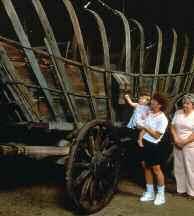
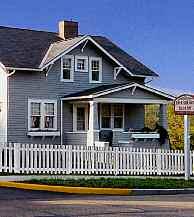
A Ceramics and Glass Heritage
The Muskingum River valley has provided clay for pottery for hundreds of years. The ceramics industry developed in the nineteenth century and reached its apex in the early twentieth century. Manufacturers such as Roseville, Shawnee, Hull, McCoy and Weller were extremely popular. Today, many of these manufacturers’ pieces are highly collectible. The Ohio Ceramic Center in Crooksville, located in Perry County, just beyond the Muskingum County line, contains exhibits devoted to the history of pottery in east central Ohio. Today Fiori and other pottery makers carry on this Muskingum County tradition.
The glass industry flourished in Cambridge and Newark during the early twentieth century. Several museums are located in the area, including the Cambridge Glass Museum (which displays over 5000 pieces of Cambridge Glass), the Degenhart Paperweight and Glass Museum, the National Cambridge Glass Collectors’ Museum and the National Heisey Glass Museum in Newark, all of which highlight the history of the glassmakers.
20
Top right: Original Conestoga wagon at the National Road/Zane Grey Museum at Norwich.
Bottom right: John and Annie Glenn Historic Site
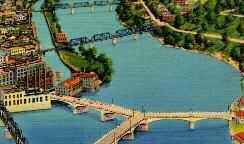
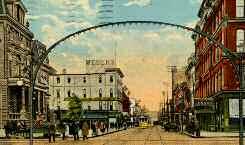
● 17 National Road/Zane Grey Museum
Don’t miss this museum specifically constructed to interpret National Road history. Owned by the Ohio Historical Society, the museum features a diorama, photographs and other exhibits of life on the Road and the vehicles that traveled it. Separate but related exhibits feature the works of western writer and Zanesville native Zane Grey and the famous Zanesville art pottery industry of the early twentieth century. The gift shop is an excellent source for publications on the history of the Road and U.S. 40. Call 1-800-752-2602 for hours of operation.
● 18 Baker’s Motel
This 1950s enlargement of an earlier motel is the midpoint on the road between Wheeling and Columbus. At one time it was the largest motel on the National Road.
Bridgeville
Just beyond (west of) Perry School on the north side of U S 40 Turn right (north) onto Bridgeville Road, an old Road segment, and proceed to a crossroads in the small Pike town of Bridgeville, where you will see a former National Road tavern on the southwest corner. Continue westbound to U.S. 40 and turn right (west).
Follow U.S. 40 west to Zanesville.Veer right onto Market Street following U.S. 40 signs. Turn left onto Underwood and right onto Main Street.
● 19 Zanesville
Zanesville is named for Ebenezer Zane who laid out the first road (Zane’s Trace) west from Wheeling, Virginia (now West Virginia), to Limestone, Kentucky (now Maysville). Zane received the choice town site on the junction of the Licking and Muskingum rivers as partial payment. Zanesville served as Ohio’s capital from 1810-1812.
● 20 Clossman Hardware, 621-623 Main Street, and Black-Elliot Block, 525 Main Street, are typical examples of post-Civil War Italianate-style commercial buildings Both currently serve as antique malls.
● 21 Muskingum County Courthouse
Designed by H.E Meyer in the Second Empire style, the current courthouse (18741877) features a mansard roof with dormers and a clock tower with domed roof, topped with iron cresting and a weathervane.
● 22 Y-Bridge
Zanesville is perhaps best known for its Y-bridge. The current bridge is the fifth to span the Muskingum and Licking rivers. Originally a covered bridge spanned the rivers Constructed in 1984, the current bridge replicates the design of the 1902 bridge that was badly damaged during the great Ohio flood of 1913. Follow directions to Putnam Park for a fine view of the bridge and downtown Zanesville
Follow U.S. 40 west
● 23 Early Service Stations
1021 West Main Street
1930s Sunoco Station, box-cube style with two service bays in porcelain enamel and steel. 1508 W. Main Street, Sinclair Station, ca. 1940s
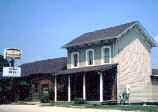
● 24 The Nelson T. Gant House
1845 West Main Street
Nelson Gant was one of Zanesville’s most prominent African American citizens. Born into slavery in 1821, Gant received his freedom in 1845 and was eventually able to buy land for a farm in Zanesville. Here he grew specialty vegetables. Local tradition claims that he often hid escaping slaves in his vegetable wagon to assist them from one safe house to another. Gant also owned a coal mine, acquired more than 300 acres and died a self-made millionaire.
21
Left: Aerial view of the famous Y-bridge showing the canal and confluence of the Licking and Muskingum rivers. Zanesville, 1930s.
Right: Main Street (The National Road) showing lighted arches, Muskingum County Courthouse on left, 1910.
Zanesville to Columbus
Just after crossing under I-70, turn right (north) at the traffic light by McDonald’s Restaurant, proceed 500 feet to National Road, turn left (west).
● 1 John Carnahen Stone Bridge
Three miles west on Township Road
420 north (old National Road), is a stone bridge built by John Carnahen in 1830. The bridge is a typical twelve-foot span with a single segmental arch and projecting keystone. However, along the National Road in Ohio, it is unique in having a stone engraved with the builder’s name and date
Turn right (west) onto U S 40
● 2 Timber Run Grange
● 3 Headley Inn, Smith House
“Cliff Rock House” ca. 1833-35 5345 Old National Road
The Headley Inn was operated by Uzal and Elisabeth Headley. It is one of the more substantial inns along the Ohio National Road. The Smith House, located just east of the Headley Inn, was operated by the Smith family as a drover’s inn. Exterior walls are massive sandstone blocks, eighteen inches thick, that were quarried from an adjacent cliff. A date stone with the owner and builder’s names marks the east wall. Note the "A. Smith" roof tile on the summer kitchen and the nearby barn. Once located next to the house, it was moved when the road was widened. When the National Road declined during the latter half of the 19th century, the Headley Inn was used as a sheep-shearing barn. Auto traffic brought its
revival as a tearoom in 1922 Today both inns are privately owned.
Just beyond (west) of the Headley Inn, turn right (north) onto an old Road segment aptly named Old National Road Here, U S 40 lies to the south, on lower ground.
● 4 Nitey-Nite Motel and Sycamore Motel
were early predecessors of the large chain establishments, and are located on U.S. 40, just south of the National Road. Just west of this location, adjoined barns, which are situated between the old Road and U.S. Rt. 40, display a classic Mail Pouch sign (see photo, page 46).
Continue west until road ends Return to U S 40 and go 6/10 of a mile
Smith House “Cliff Rock House”, an early tavern located between Zanesville and Mount Sterling.
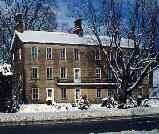
● 5 Spring Box
Built into the hillside, and located on the north side of the Road, just east of 7275 Old National Road, this stone object captured spring water for thirsty travelers along the National Road.
● 6 Reciprocity Bridge
This 1830 stone bridge was named Reciprocity (tit for tat) for a Congressional inspection committee comprised of representatives from Indiana and Ohio, who cut a deal about the Road as they were riding toward this bridge
Turn right (north) onto an old Road segment known as County Road 415, and continue west to Mount Sterling The four-lane U S 40 lies to the south
Mount Sterling
Mount Sterling is a small Pike town that was built on two hills separated by a hollow In 1836, Henry Clay and other congressmen were in a stagecoach that overturned at the bottom of the East Hill. The location of the accident was still remembered in the 1940s by the name, “Congress Hollow ”
● 7 Tavener-Sears Tavern
Former National Road tavern located near where Flint Ridge Road intersects with the old Road in Mount Sterling, now a private residence.
40 Franklinton 1 4 5 6 7 8 2 3 9 10 14 11 13 16 15 18 21 20 28 32 29 27 26 35 12 17 19 22 23 24 25 30 31 33 34 Etna Wagram Linnville Jacksontown Brownsville Luray Hebron Gratiot Amsterdam Kirkersville Mt. Sterling Columbus Zanesville Reynoldsburg Whitehall Bexley 70 71 Moraine 0 2 5 5 7 5 10 Miles 22
Muskingum
County/Licking County/Franklin County
Continue westbound through Mount Sterling to the small settlement of Hopewell, where you’ll intersect with U S 40 Turn right (west)
LICKING COUNTY
Turn right onto County Road 1, Main Street (old National Road) west through Gratiot.
Gratiot
This Pike town was named for Brig. Gen. Charles Gratiot, Army Corps of Engineers, an early Road administrator.
● 8 Stone Bridge
Just west of Gratiot, is an excellent stone arch bridge that spans Valley Run.
Continue west on County Road 26, then turn right (west) onto U.S. 40.
Brownsville Vicinity
According to the 1875 Licking County Atlas, Brownsville was originally platted with a town square. Later, a realignment of the Road led to the removal of the square. On the north side of the Road, just past the south intersection of Ohio Route 668, stood a ca. 1826 brick tavern, known variously as the National Hotel, the Old Coach Inn and the Balthis Inn. It served travelers in the first part of the 20th century as a hotel. Farther west in town, an old grist mill sits on the north side of the Road in Berry Run Valley
● 9 Eagle’s Nest Monument
On the north side of the Road, about a mile west of Brownsville, is the Eagle’s Nest Monument, a large granite rock with an inscription commemorating the concrete paving of the National Road from Zanesville to Hebron, from 1914 to 1916. The inscription on the rock reads:
Old National Road
Built 1825. Rebuilt 1914
Through the efforts of James M. Cox Governor of Ohio
Also chiseled in the granite are renderings of a Conestoga wagon and an early automobile, as well as the distances to Columbus (32 miles) and Cumberland, Maryland (220 miles).
The 2nd Frontier (across from Eagle’s Nest Monument)
Thousands of people flocked to two farms owned by the Rodman and Latham families, just west of Eagle’s Nest, on Open Woods Road, a bypassed segment of the Road, on October 2, 1947, to witness an event called “The 2nd Frontier.” Those present saw a new and innovative approach to soil conservation on rolling fields termed “contour farming.” Not only was this important agricultural demonstration covered by print media from all over the world, it was also broadcast by a number of radio stations, including the giant Cincinnati WLW, a part of Crosley Broadcasting, with its new media, television, present in a fully-equipped broadcast bus. The experimental station, W8XCT, also provided a groundbreaking event of its own – the first television broadcast in this part of Ohio.
● 10 Licking County Pike Towns
Gratiot, Brownsville, Linnville, Amsterdam, Jacksontown, Hebron, Luray, Kirkersville, Etna and Wagram all retain their National Road “Main Streets”, with a variety of nineteenth and early twentieth century buildings.
Proceed west to stop sign, turn left (west) onto U.S. 40, and continue westward a short distance to Fairmount Road (Licking Township Road 323) and turn right (north)
● 11 Indian Mound
A few hundred feet ahead on the right is the Fairmount Presbyterian Church built in 1883. The congregation dates to 1833, about the time the Road was built through this area. The church’s cemetery is home to a Hopewell Culture Indian mound.
● 12 Terminal Moraine
This area is the terminal moraine of the Wisconsin Glacier and a good point from which to view the manner in which the National Road followed the topography while U.S. 40 cut and filled its way directly across the land.
Amsterdam Vicinity
A little more than a mile west of mile marker 223 is Cinder Tipple Road Turn right (north) and then left (west) onto an original concrete segment of the old Road.
A Ribbon of Concrete
Several cement remnants of the Road located in Muskingum and Licking counties were part of a federally subsidized experiment, from 1913-1916, to test a variety of road materials under different kinds of weather and soil conditions. The paved segment of Road stretched from Zanesville to the south fork of the Licking River near Hebron. Though local brick manufacturers preferred that the paving be done with their product, the lower cost cement eventually won out. The finished smooth strip of concrete proved irresistible to motorists who soon took to joy-riding in ever larger numbers. As might have been predicted, the new Road also encouraged higher speeds, which soon led to a highway casualty near Zanesville. To celebrate the completion of the new Road, the Zanesville Chamber of Commerce sponsored a “trade excursion” from Zanesville to Jacksontown. In November, 1916 a fleet of “autoists” with their “machines” gaily decorated with bunting and streamers made the trip.
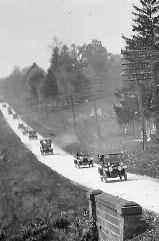
23
Caravan on new concrete Road west of Zanesville, November, 1916.
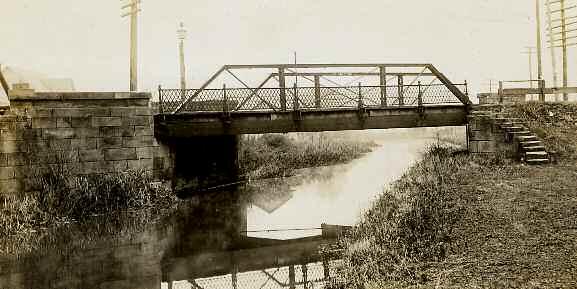
Where the Water Meets the Road
The Ohio & Erie Canal and the Road
In a remarkable coincidence of Ohio history, groundbreaking for two of Ohio’s greatest construction projects occurred on the same day: July 4, 1825. Groundbreaking for the National Road occurred in St. Clairsville, opposite the old courthouse, while the Ohio and Erie Canal commenced construction at Licking Summit (now Heath), just north of Hebron. The Road and the Canal intersected at Hebron. Few communities in the nation could claim such easy access to two such important corridors of travel and commerce.
Ironically, the Road and the Canal also suffered a similar fate. Already overshadowed by the railroad as a faster and more efficient mode of travel even before they were finished, their decline also paralleled each other. Today the similarities continue. Both the National Road and the Ohio & Erie Canal have received national recognition and are undergoing a revival as heritage tourism destinations for a new generation of travelers.
Continue west back to U S 40, turn right (west), then almost immediately left (south) at Twp Rd 817 onto another concrete old Road segment.
Here you will see a stone bridge spanning a deep ravine The bridge has one surviving principal corner stone on its south side wall It is the only one of its kind found on the surviving bridges between Bridgeport and Columbus.
● 13 Presbyterian Church
Jacksontown
Known by locals as “Jacktown,” this Pike town once had a stagecoach inn on the northwest corner that served National Road travelers The inn had a dining room, bar, billiard hall, barbershop and thirteen sleeping rooms The Clark family purchased the inn in 1918 and it was operated as Clark’s Hotel On Labor Day, 1954, the old landmark burned to the ground, and the family built a new restaurant known as Clark’s Restaurant. This business is now closed.
● 14 National Road Railroad Station
On the north side of the Road at Lancers Road stands the National Road station, a stop on the Newark, Somerset & Straitsville Railroad (later, the Baltimore & Ohio RR), that served as a connection point between the Road and Newark to the north, and to Buckeye Lake and points south. A few feet up the Road on the north side are the buildings of the former National Trail Restaurant and Tourist Court.
Hebron
● 15 Hebron Mill and Canal (See sidebar at left)
The location at which the Ohio & Erie Canal and the National Road intersects in Hebron, the intersection of Basin Street and Main Street, clearly shows the angle at which the canal and the Road met. Hebron marks this significant spot with a monument just west of Main and Basin streets, near the landmark 19th century Hebron Mill.
24
National Road bridge over Ohio & Erie Canal at Hebron, 1910.
Right: Looking east on Main Street in Hebron shows the muddy, rutted roadway, interurban tracks and Hebron Mill in the distance, 1910.
● 16 Hebron
Throughout the nineteenth and early twentieth centuries Hebron continued to be a center of transportation. The Toledo and Ohio Central Railroad (T&OC, later known as the New York Central Railroad) crossed the Road just west of the intersection of High and Main Streets. The town was also served by the interurban out of Columbus in the early 1900s.
Luray
On Tuesday, November 10, 1936, many eyes from around the country were on the Alva Oyler farm at the southwest corner of the National Road and Ohio Rt 37, as the National and State Corn Husking Contests were held here A nationwide radio broadcast told of the contests to listeners around the country The Columbus Dispatch and many other daily newspapers covered the event which, they reported, attracted a crowd estimated at between 135,000 and 160,000 people An Iowa farmer won, husking 21.04 bushels in 80 minutes. Today, manual corn husking is almost unheard of in this country.
Kirkersville
● 17 Interurbans
(See sidebar page 26)
Founded in 1815 by Thomas Kirker, Governor of Ohio, 1807-1808, and incorporated as a village in 1911, this Pike town
once had several taverns. President John Quincy Adams dined at Neiswander’s Tavern, in 1843, fourteen years after he left the White House. A major fire in March, 1905 destroyed all but one of the buildings on the north side of the National Road between Third and Fourth Streets Some of the buildings that replaced those destroyed in the fire were built with second floors that extend over the sidewalk and storefronts, creating an arcaded sidewalk Two original interurban depots are located at 172 and 175 E. Main Street.
● 18 Shamrock Motel
Just west of Kirkersville on the south side of U.S. 40 is the 1930s Shamrock Motel with its unusual brick tudor design. The frame restaurant was designed to look like the national Howard Johnson’s chain of the time, right down to the roof color and design with its two dormers and cupola, and the sign shape and lettering out front.
Just beyond Smoke Road (Etna Twp Rd 152), turn left (south) onto Pike Street (Licking County Road 1) and proceed westward into the Pike town of Etna
Etna
On the northeast corner of the old Road and Ohio Rt 310 is a park that was originally set aside when the town was platted in the early 1800s as a site for the future Licking County courthouse However,
Newark got the courthouse and Etna got the National Road and a nice park. The second building on the left after crossing Ohio Rt. 310, just past the old brick church, was the Etna interurban depot from 1902-1929.
Continue west on Pike Street to stop sign Turn left (west) and continue through the small Pike town of Wagram to Reynoldsburg
FRANKLIN COUNTY
A brochure of National Road sites in Columbus is available at the City of Columbus Department of Development, Historic Preservation Office, 614-645-8620.
Follow U.S. 40 west through Reynoldsburg and Bexley.
Reynoldsburg
Reynoldsburg was platted in 1831 by John D. French, who hoped to prosper from National Road traffic. His five-bay, Federal-style house is located at 7304 Main Street. The town is named for James Reynolds, an early settler whose store mail was addressed to ‘Reynolds Burg’ Reynoldsburg recently completed a streetscape reconstruction.
From Reynoldsburg to near downtown Columbus, much of the original National Road landscape has been replaced by commercial strip development typical of the late 20th century American roadside
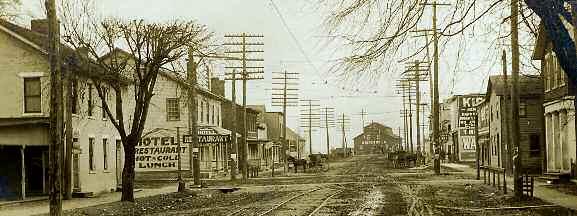
25
Whitehall
The village of Whitehall was incorporated in 1947. The name “Whitehall” is derived from Robert Brotherton of White Hall, England, who owned the land in the early 1800s By the late 1800s a small farm community had adopted the name and in 1910, Samuel Doney platted a town known during the interurban era as “Doneys,” and today referred to as “Old Whitehall ” While it is not located on the Road, the Town & Country shopping center, built in 1947, is acknowledged as the nation’s first regional shopping center designed in the conventional strip configuration, with total offstreet parking. Watch for numerous 1950s and 1960s motels along this section of the Road. Built prior to the construction of Interstate 70, many, such as the Colonial, the Capital, the Columbus Motor Lodge, the Casa Villa and the Brookside still operate as motels while others now function as apartments.
How West Broad Street became Part of the National Road
The National Road originally entered the city of Columbus on Friend Street (now Main Street) Because there was no bridge across the Scioto River at Friend and High Streets, the Road jogged four blocks north
to Broad Street, where the son of Lucas Sullivant, the original white settler of the pre-Columbus settlement of Franklinton, had built a bridge several years earlier. The superintendent in charge of the National Road’s construction paid Sullivant $10,000 for the bridge and the Road continued its trek west The jog from Main Street to Broad Street was later moved east to Drexel Avenue in Bexley You may take either route, or backtrack and take both
Turn right (north) on Drexel Avenue to Broad Street Turn left (west) on Broad Street and follow it into downtown Columbus From this point westward, Broad Street is U S 40
Main Street Route
● 19 Engine House No. 11 (1898)
100 East Main Street
Typical of late 19th century fire stations, Engine House 11 symbolizes the growth patterns spawned by the National Road which made E. Main Street the commercial corridor around which residential neighborhoods developed.
● 20 Ohio State Arsenal
139 West Main Street
Constructed in 1861 at a cost of $14,000, this building was designed specifically for the storage of arms. It originally housed the

Where the Rails Meet the Road
On December 28, 1889, the Newark and Granville Street Railway, the first electric interurban line in the United States, began operating in Licking County. A year earlier, inventor Frank J. Sprague had proved that horsepowered streetcars could be converted to electric motor propulsion with electricity drawn from overhead wires. Sometimes called trolleys, the lines soon stretched from downtowns into the suburbs and from rural railroad stations into the countryside. By 1916, over 1000 firms owned more than 60,000 miles of track nationwide. Lines quickly expanded along the National Road. In 1900-01, the Columbus, Buckeye Lake and Newark built a line from Columbus to Zanesville via Newark, rather than along the National Road as had been proposed, due to the exorbitant prices sought by property owners along the Road for the right-of-way. After several mergers, a successor line known as the Ohio Electric continued to expand service. Other companies built lines that ran through Belmont County, through Bridgeport, Blaine and St. Clairsville and west from Columbus into Madison and Clark counties, and through Springfield where connections could be made for nearly any destination. As electric service was expanded to serve the rail system, inexpensive power became available to residents and businesses along the routes. Despite the convenience interurban systems offered city dwellers and rural residents, gasoline-powered buses and automobiles quickly spelled the end of this remarkable transportation network. The last cars rumbled along the rails beside the National Road in the 1920s.
26
Looking east on Main Street in Kirkersville, note the interurban car and beyond, the double covered bridge crossing the feeder canal, 1909
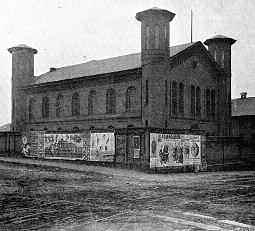

public arms of the State of Ohio In 1978 the building became the Columbus Cultural Arts Center, saving and transforming this important historical building
● 21 Columbus Health Department (formerly Ohio Asylum for the Blind) 240 Parsons Avenue at Main Street
The former Ohio Asylum for the Blind was constructed in the Second Empire style between 1869 and 1874. It was “ one of several State institutions of great size and grandeur constructed almost simultaneously and was part of Governor Rutherford B. Hayes’ vast capital building program after the Civil War ” At this time Ohio was a leader in the establishment of State institutions for the handicapped. As built, this institution formed a large “U” and fronted Main Street (the National Road). It originally included a five-story central tower. Though minus the tower, the huge main block of the building survives Today the building houses the Columbus Health Department.

Bexley
In 1898 this area was the assembly site for 8000 Ohio volunteers headed for Cuba during the Spanish American War. Known as Camp Bushnell, for then Governor Asa Bushnell, the site was disbanded following the war. Sewer and water lines, extending from the camp to Columbus, stimulated
27
Clockwise from top: Ohio State Arsenal, present day Columbus Health Department, Engine House No. 11 from Main Street.

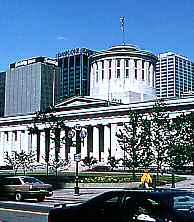
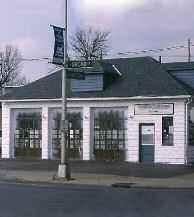
real estate development. The city of Bexley incorporated as a village in 1908 and a city in 1932. Bexley’s residential architecture reflects the affluence of this early 20th century community.
Columbus
When Ohio became a state in 1803, Chillicothe served as the first capital, until political disputes temporarily shifted the seat of government to Zanesville in 18101812 Legislators finally agreed to place the permanent capital near the geographical center of the state and close to a navigable river. At first, few people occupied the east side of the river, choosing instead to live in nearby Franklinton. By 1812, the first streets had been laid out and 300 people occupied the city one year later. A new statehouse was completed, and the General Assembly held their first meeting there in 1816.
● 22 1900 East Broad Street
After passing beneath the 1930s Norfolk and Western railroad overpass, look for the Franklin Park Conservatory on your left and its neighboring Victorian-era residences. Then on your right, you’ll see Columbus East High School, an architectural gem then and now. During the 19th
and early 20th centuries, East Broad Street was home to many of the city’s affluent residents. Several of the numerous mansions which once lined the street remain, including the old Governor’s Mansion at the northeast corner of Governors Place and East Broad Street. (See #24)
● 23 Franklin Park Conservatory
1777 East Broad Street
Located on the south side of Broad Street is a site of about 100 acres that was used as the Franklin County Fairgrounds from 1886 to 1894 The Conservatory includes a building of glass, stone and steel that once graced the 1893 Columbian Exhibition. It was disassembled, transported from Chicago to Columbus, and erected here in 1895. Today, the Conservatory is home to over 250 flowers, trees and shrubs native to tropical and desert countries.
● 24 Old Governor’s Mansion
1234 East Broad Street
Well-known Columbus architect Frank Packard designed what was to become Ohio’s first State-owned governor ’ s residence. The home occupies a six acre site on the north side of Broad Street. The first governor ’ s family to occupy the mansion, in December, 1920, was Governor James M.
28
Above: This view, drawn by Henry Howe in 1846, is looking south on High Street On the right is the old Neil House and on the left is the old Ohio State Capitol. Left: Ohio Statehouse. Bottom left: 1940s service station.
Cox and his wife. The last gubernatorial resident was C. William O’Neill in 1957, just prior to his moving to a new home for Ohio’s chief executives on Parkview Avenue in Bexley.
● 25 Ohio Statehouse/ Ohio State Capital NATIONAL HISTORIC LANDMARK
Constructed between 1839 and 1861, the Ohio Statehouse is considered one of the finest examples of Greek Revival Style architecture in the United States Henry Walters won the competition to design the building The third prize was awarded to landscape painter Thomas Cole (The Architects Dream, 1840) Alexander Jackson Davis was then hired as a consultant The result is a building that is at the same time, bold, massive, austere and masculine, one of the most forceful and unadulterated among the Greek State capitals, or “temples of democracy” as they are sometimes called. The building underwent a $112 million dollar restoration in the late 1990s.
● 26 Great Southern Hotel and Theater
296 South High Street and 21 East Main Street (the original National Road)
Now a Westin Hotel, the Great Southern and the adjacent Southern Theater were
constructed from 1894-97. They are Columbus’ only remaining 19th century hotel and theater and continue to provide lodging and entertainment just as they did in the earliest days of the automobile.
● 27 AIU Citadel (LeVeque Tower)
50 West Broad Street
Back on U.S. 40, one block west of High Street on the right is the 55-story AIU Citadel (LeVeque Tower). Constructed beginning in 1927, it was the first skyscraper in Columbus. Designed by architect C. Howard Crane of Detroit, and built for the American Insurance Union (AIU), the building has seen a succession of owners. During the Depression, the AIU filed for bankruptcy, prompting some local wags to refer to the tower as the “IOU” building. The Keith Albee Theater, with seating for 4000 patrons, was located in an east wing of the building at 34 West Broad Street Today it’s known as the Palace Theater and is a venue for numerous presentations, both live and filmed
● 28 Ohio State Office Building
65 South Front Street (southwest corner of West Broad Street and South Front Street)
In an attempt to consolidate the locations of various State offices spread around downtown
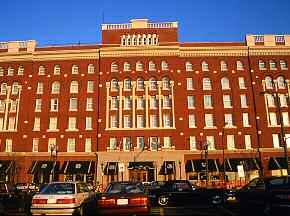


29
Right: LeVeque Tower.
Bottom left: Great Southern Hotel and Theater
Bottom right: The Franklin Park Conservatory
Columbus, the Ohio legislature enacted legislation in 1929 authorizing this building. Designed by Cincinnati architect Harry Hake, in the then-popular Art Deco style, the building was constructed during the terms of Ohio Governors Myers Y. Cooper (1929-1931) and George White (1931-1935)
Over the years, it has housed numerous State departments. Made of Georgia marble, the 14 story building underwent an extensive restoration in the early 2000s and is now home to the Ohio Supreme Court. Of particular interest are the panel murals reflecting the talent and various techniques of artists during the 1930s, two reflecting pools and the landscaped setting
On your right just before crossing the Broad Street Bridge is the Columbus City Hall (90 West Broad Street) and behind it, the Federal Courthouse (85 Marconi Boulevard)
Franklinton
As you cross the Broad Street Bridge over the Scioto River you enter the neighborhood of Franklinton. Franklinton is actually older than Columbus, having been founded in 1797 by Lucas Sullivant. When Ohio became a state in 1803, the county of Franklin was formed and Franklinton was named the county seat. Because of its location near the confluence of the Olentangy and Scioto rivers in the Scioto flood plain, Franklinton was devastated by the flood of 1913, with nearly 100 lives lost and over 1,000 homes destroyed Today Franklinton is one of many Columbus neighborhoods A flood wall was finally constructed beginning in 1993 and finished in 2004, a joint effort of the city of Columbus and the U S Army Corp of Engineers
● 29 Central High School (COSI)
333 West Broad Street
Situated on a prime site of 17 87 acres, Central High School incorporates several outstanding architectural features, including a monumental columned entrance facing the Scioto River, sunken courtyards and classical detailing throughout. Designed by the prominent St Louis architect William
B. Ittner, a major figure in innovative school building design during the early decades of the 20th century, and built in 1924, Central was the descendant of the original public “High School of Columbus”. After closing and being sold to the City of Columbus in 1982, it was the site of a Chinese art exhibit, the “Son of Heaven”. With the construction of a major addition, it is now the home of the Center of Science and Industry (COSI). Located across the road is Veterans Memorial Auditorium (300 West Broad Street).
● 30 Toledo and Ohio Central (T&OC) Railroad Station
379 West Broad Street
Columbus’ only remaining railroad station, built in 1895 with a pagoda style tower, the T&OC station is one of Central Ohio’s greatest architectural oddities. The station was used until 1930, when the then-New York Central transferred its functions to Columbus’ Union Station. The station was restored in 2006.
● 31 Oberdoer House, aka “Harrison House” 1807
570 West Broad Street at Gift Street
This modest three-bay Federal-style house was built by Jacob Oberdoer and was used by General William Henry Harrison in the winter of 1813-14, as his headquarters during the War of 1812. It is now the office of the Franklin County Genealogical Society and is open during their business hours. Behind the Oberdoer House is the relocated house Lucas Sullivant used as his Franklinton land office.
The Hilltop
West of the U S 40 intersection with I-70, the Road begins a climb to the neighborhood known as The Hilltop. On the north side of the Road at the top of the hill are the large modern buildings that house the Ohio Highway Patrol and the Ohio Department of Transportation. This is the former site of the Columbus Lunatic Asylum, later the Columbus Psychiatric Hospital. Today’s Hilltop is a largely residential area with commercial establishments fronting on U S 40
● 32 Engine House No. 10
Turn left (south) on Hague Avenue and then right (west) on Sullivant Avenue
● 33 Camp Chase, Confederate Cemetery
Here you can view the walled Camp Chase cemetery with its rows of white military tombstones of Confederate prisoners who died at this former 165-acre Civil War Camp The cemetery is open to the public Parking is limited on adjacent side streets. Retrace your route and turn west on Broad Street, imagining the many regiments of Ohio troops, which mustered in and trained at Camp Chase (see sidebar at right) and then marched east along the National Road to the Columbus station to board trains that would transport them to battlefields in the south. The West Gate Masonic Lodge at 2925 West Broad, marks the approximate location of the camp ’ s main gate. An historic marker east of Binns Boulevard, gives a brief history. The lodge and historic marker are located on the south side of the Road
● 34 2464 and 2570 West Broad Street
Located on the north side of the street at 2464 West Broad at Eldora Avenue and 2570 West Broad at Burgess Avenue, these ca. 1940s service stations are two of several surviving U.S. 40 stations.
● 35 40 Motel
You probably can’t miss the famous 40 Motel neon sign with its large arrow pointing to this 1950s U.S. 40 motel.
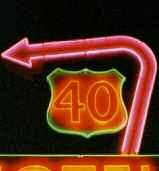
30
40 Motel sign, U.S. 40, Columbus.
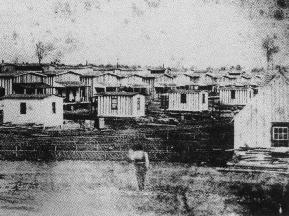
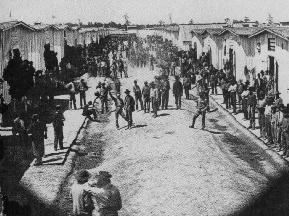
Camp Chase, Confederate Cemetery
Camp Chase, established to replace Camp Jackson, was located along the National Road in May, 1861 to facilitate the movement of Union recruits for training. In June, 1861, it was occupied by 5 U.S. regiments and named Camp Chase in honor of Salmon P. Chase, ex-governor of Ohio and Secretary of the Treasury in President Lincoln’s cabinet. It is estimated that over 150,000 Union troops passed through the gates of Camp Chase. Four future U.S. Presidents were stationed at Camp Chase: Andrew Johnson, Rutherford B. Hayes, James A. Garfield, and William McKinley.
As early as July of 1861, Camp Chase erected a small “make-do” prison to handle the influx of political prisoners or disloyal citizens that were being captured, questioned, and in most cases, released.
The prison was enlarged to accomodate Confedrate prisoners of war in the fall of 1861. By March, 1862, Camp Chase contained three separate prisons holding over 1,200 prisoners, mostly officers captured at Fort Henry and Fort Donaldson in Tennessee. The population increased during the war and by February, 1865, had grown to 9,045 prisoners.
Blue & Gray Magazine editor, David Roth, has determined that the main gate of Camp Chase was located next to the West Gate Masonic Lodge on West Broad Street, (U.S. 40) The National Road. Roth’s research has identified the location of the camp although now a residential subdivision (Westgate). The camp location can be overlayed for future walking tours.
Camp Chase Cemetery is the largest Confederate cemetery outside the south. There are over 2,100 Confederate Civil War soldiers buried in the cemetery. Camp Chase Cemetery is located approximately 1/3 mile south of the former Camp Chase prison, at 2900 Sullivant Avenue. The cemetery is open to the public.
During the Civil War, the ground for Camp Chase was leased and was returned to civilian ownership following the war. On February 25, 1879, the Federal Government (45th Congress) purchased the 2.5 acre cemetery ground.
The first memorial service was held June, 1895, and continues every year on Confederate Memorial Day, June 4th. Each year, representatives from the southern states attend and read commendation letters from their states’ Governors.
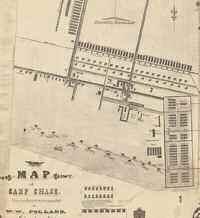

31
Top left: Camp Chase, showing the barracks occupied by the 88th Ohio Infantry for most of the war. The view is looking northeast from Headquarters Avenue. Top right: Prison No. 3, viewed from the south wall, ca. 1864-65. Middle: map of Camp Chase. Bottom: Camp Chase Headquarters and the base of the 150-foot flagpole. Partially in view at left is the J.N. Marple boarding house.
New Rome
The village of Rome, later “New Rome,” was laid out the same year as Alton, with 32 lots on the north and south sides of the National Road. The village was incorporated in 1941 and unincorporated in 2004
Most of the remaining homes have been converted to businesses and little remains of its nineteenth century character.
Alton
Just west of the Columbus city limits is the village of Alton. Alton was laid out by Thomas Graham in 1836, following the construction of the National Road.
● 1 B&B Lodge
9420 West National Road
The seven remaining cottages of this post World War II motor court are typical of the early row courts that ran perpendicular to the highway.
● 2 Concrete Arch Bridge
The Road crosses Big Darby Creek on a concrete arch bridge ca 1940
Madison County
West Jefferson
Originally established as New Hampton, West Jefferson was platted in 1822. The old
State Road ran through the community and served as the stage route across the county. When the National Road was constructed through the town, village dwellings and businesses literally moved to the new highway, in effect creating a new town, which was replatted as Jefferson in 1831.
●
3 U.S. Routes 40 and 42 Interchange
When this pre-interstate, major intersection was upgraded in the 1930s, a new technique was employed utilizing an early interchange configuration. The cloverleaf and ramps had a primitive similarity to today’s interchanges. Another relic of that bygone era, Fettrow
Village, sits in lonely repose just northeast of the interchange.
Lafayette
Lafayette was laid out by William Minter in 1837, the same year the National Road was completed through the county. This Pike town is near the intersection of the Road and U.S. 42.
● 4 Red Brick Tavern
1700 Cumberland Road
Lafayette is the home of the famous Red Brick Tavern listed on the National Register of Historic Places. The Tavern has hosted
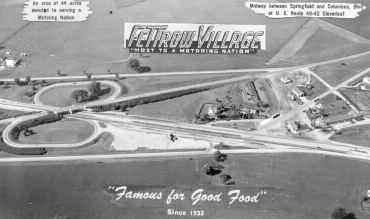
32 40 70 315 71 1 3 2 4 9 6 8 7 5 Columbus Sp r ingfield New Rome Alton Summerford Donnelsville Harmony Brighton South Vienna Lafayette West Jefferson 71 02468 Miles Franklin County/Madison County/Clark County
Springfield
Columbus to
1950s postcard of Fettrow Village and cloverleaf.
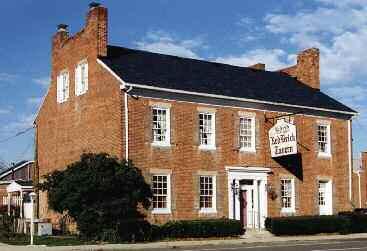
Squabbling about the Route
The legislation authorizing the construction of the National Road mandated a strict east-west route through the capitals of Ohio, Indiana and Illinois. However, this did not stop local town boosters from advocating alterations to the route if their communities were being bypassed. Between 1825 and 1833, residents of Newark and Granville objected to the route from Zanesville to Columbus. An existing stage route which followed Sullivant‘s Trace (now Ohio Rt. 16) already existed, they argued, but Columbus business leaders ultimately prevailed and the Road followed Friend Street (later Main Street) to High Street, where a growing number of businesses had sprung up.
THE COUNTERFEIT PIKE - The argument over the route in Licking County was mild in comparison to the objections raised by Dayton and Eaton boosters when these two southwestern Ohio communities were bypassed by the straighter route through Springfield. The two communities managed to halt construction for ten years, by advocating for a short diversion south and west before rejoining the National Road near Richmond, Indiana.
such famous people as Henry Clay and U.S. Presidents John Quincy Adams, Martin Van Buren, William Henry Harrison, John Tyler, Zachary Taylor and Warren G. Harding. A barn, now demolished, at the rear of the tavern was used to house the horses for the mail relay riders who delivered mail for a short time.
On the north side of the Road, just east of State Route 38, is the Molly Caren Center, site of The Ohio State University Extension Service’s annual Farm Science Review, a massive exhibition of the latest agricultural science and technology.
Follow U S 40 (west) to Summerford Turn right (west) onto the old National Road through Summerford, then right to return to U S 40 (west).
Though they recruited state legislators to present their case to Washington, President Andrew Jackson decided against the alternate route. Undaunted, Dayton boosters decided to construct a copycat turnpike known locally as the ”Dayton cutoff,” (Rt. 4, Lower Valley Pike, U.S. 35). Contracts were let in 1838 and a replica road was constructed including a similar roadbed, bridges, toll gates, stone culverts and even milestones showing the distance from Cumberland, Maryland. The Dayton Cutoff was often mistaken for the National Road and was so effective in steering travelers south that a 1925 Ohio transportation survey noted that the National Road from Brandt to the Indiana border remained largely unimproved and served primarily local traffic.
THE MISSING ROADSCAPE – Because the Dayton Cutoff was so successful in rerouting traffic from the National Road, many of the nineteenth century inns, taverns, milestones and other resources associated with the nineteenth century travel are absent from Springfield to the state line.
33
Red Brick Tavern, Lafayette
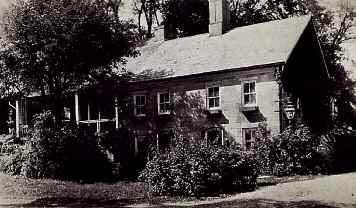
Accommodating the Nineteenth Century Traveler
During the early nineteenth century, inns and taverns were constructed approximately every ten miles along the Road because this was the distance a wagon or stagecoach could expect to travel in a day. These early predecessors to the twentieth century cabin camp, motor court and later, the motel, offered some respite from the rigors of interstate travel. Inns and taverns also offered social experiences for those who wished to take part. Though some ate their evening meal and retired for the night, others lingered around the fire telling stories, exchanging experiences of the Road, singing, dancing and discussing the important issues of the day.
Inns were often located at the crest of hills in outlying areas and were among the most prominent buildings on the Main Street (the National Road) of many Pike towns. Drover’s inns and services were generally located on side streets parallel to the National Road or on the outskirts of town where they could accommodate pens for livestock being driven to market. Drover’s inns were generally simpler frame structures. The sleepy nature of many National Road towns today makes it difficult to realize the proliferation of services available during the nineteenth century heyday of the Road. An 1831 state gazetteer listed the tiny town of Etna in Licking County with 3 taverns, 6 stores and 34 dwellings. West Jefferson in Madison County was home to 5 taverns and 6 stores.

Summerford
Summerford was laid out about 1836 by Joseph Chrisman, who also owned the first tavern and store
Clark County
Brighton
U.S. 40 continues as a four-lane divided highway at Brighton with a wide median that actually encompasses a large part of the town. On the south side of the westbound road, at 12971, is the old Brighton Powerhouse, now a private home. Built in 1902, it provided electric power for the Columbus, London and Springfield interurban railroad that paralleled the National Road.
Bear right (north) onto the old route through South Vienna
South Vienna
John H. Dynes founded the village in 1833, naming it Vienna, after Vienna, Austria It was later changed to South Vienna, because there was already a Vienna in Trumbull County Today South Vienna is the center of a tight-knit farming community South Vienna celebrates it agricultural heritage each September with a Corn Festival
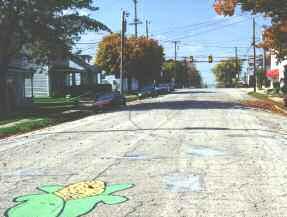
34
Top: Headley Inn, Old National Road, near Zanesville, Ohio, built ca. 1833. Bottom: (left) Buena Vista Tavern, built ca 1836 (right) Street scene of the Road in South Vienna with Corn Festival logo painted on the street, 1990s.
● 5 First Ohio Traffic Signal by Permit
The intersection of State Route 54 and U.S. 40 is the site of the first traffic signal for which a permit was issued in the state of Ohio.
● 6 Buena Vista Tavern
8518 Old National Road
Also known as the Old Weaber Place, the Buena Vista Tavern was constructed in 1836 and operated as an inn from 1849 to 1856 During the early twentieth century, a cabin camp located at the rear of the old inn, offered motorists lodging Several cabins remain Today the former inn houses Johnson’s Lamp Shop
Follow U.S. 40 (west) into Springfield
Harmony
Another of the smaller Pike towns along the Road that had businesses which catered to the needs of both travelers and local residents.
● 7 Buchwalter House (Oak Hill Farm)
4465 East National Road
Located on 120 acres of land, the Buchwalter house was constructed in the 1820s and enlarged about 1870. The house was reportedly a stop on the Underground Railroad, while the land may have ties to Ohio’s Native American population as the site of a summer Indian village.
● 8 Davidson Nature Park
4465 East National Road
Also located on the property is the Davidson Nature Park, which includes over four miles of trails and a small museum housing Carleton Davidson and Shawnee Indian memorabilia. The Park trails are open to the public while the museum is open by appointment only. For access to the park or more information contact Ed Rice at 937/322-0378.
● 9 Melody Cruise-In Theatre
4025 East National Road
About two miles west of Harmony is the Melody Cruise-In Theatre. Opened in 1952, it is still in operation. The Melody Cruise-In is a rare survivor of numerous outdoor theaters that dotted Ohio in the 1950s.
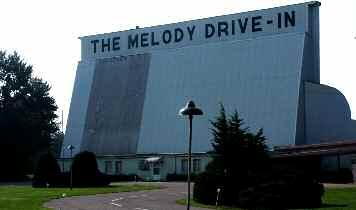


35
Right: (top) Melody Cruise-In Theatre (bottom) Buchwalter House
Springfield to Englewood
Follow U.S. 40 (west) into Springfield. After passing a lengthy commercial strip, veer left then right onto Main Street (west) and follow it through Springfield. In downtown Springfield the road splits at Spring Street and follows two one-way streets: West on Main Street and East on High Street from Yellow Springs Street to Greenmount Avenue. While passing through this area, watch for remnants of a 1950s era auto service industry, including motels and cabins. The Drake and Fairfax are two of the more prominent motels along the route.

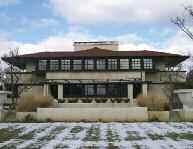
Springfield
John Daugherty platted a settlement here in 180l, nearly forty years before the arrival of the National Road. The Road reached Springfield in 1838, where controversy over the route west (see Squabbling About the Route, page 33) delayed further construction, and Springfield became known as the town at the end of the Pike
● 1 Springfield Township
● 2 Old Town Tavern
204 East Main Street
Now severely altered, this ca 1840s National Road building at the northeast corner of Spring and Main streets, has served as a boot and shoe tannery, a doctor’s office and a restaurant.
● 3 Westcott House
1340 East High Street
The Burton J. Westcott House was designed by Frank Lloyd Wright and is his only Prairie style home in Ohio. The house was designed in 1906 and completed in 1908. In the 1940s, the open floor plan was changed significantly into multi-unit apartments which compromised the original architectural design. The Westcott House recently underwent a $5.3 million dollar restoration.
The Westcott House is open Wednesday through Saturday, 11:00 a.m. – 5:00 p.m.
● 4 Shawnee Hotel
Now converted to Shawnee Place Apartments, the 1915 Shawnee Hotel on the northeast corner of Main Street and Limestone is an impressive eight-story Neo-Classical hotel building designed by H. Ziegler Dietz of St. Louis. The building features a massive cornice and a two-story lobby with a grand staircase to the balcony and marble and walnut trim.
● 5 Bushnell Building
14 East Main Street
The Bushnell Building was built by Governor Asa Bushnell in 1893 and originally housed the First National Bank, U.S. Depository and Kinnane’s Dry Goods Store. The 2nd, 3rd and 4th floors were used as office space and Masonic Temple occupied the 5th floor. Harry L. Toulmin, the patent attorney who applied for and defended the patents for the Wright Brothers on several parts of their airplane, practiced in the building. In 1994, Springfield Attorney James H. Lagos bought the vacant building and has restored it to use for several local businesses.
36 70 40 2 3 4 7 8 9 11 1 6 5 10 12 14 16 17 13 15 4 4 4 Sp r ingfield
Englewood Brandt
I75 01234 Miles
County
Top: Bushnell Building. Bottom: Westcott House
Vandalia
Phoneton Donnelsville
Clark County/Miami County/Montgomery
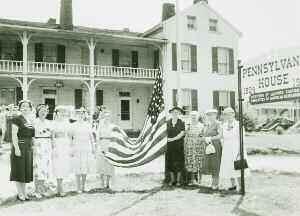
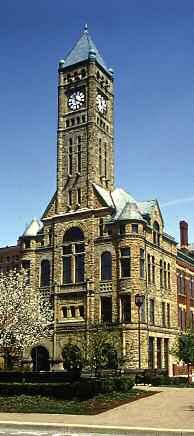
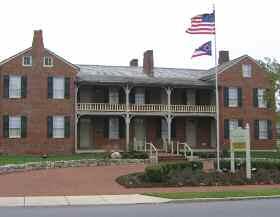
● 6 The Clark County Heritage Center, 1887-1890 City Hall and Marketplace
The Clark County Heritage Center was originally constructed as Springfield’s City Building and marketplace. Architect Charles A. Cregar designed the building in the Richardsonian Romanesque style, which is defined by its massive stonework, arches and towers. The building is a block long and just fifty feet wide. The building underwent a multi-million dollar renovation in the late 1990s and today houses the collections of the Clark County Historical Society The center includes a major National Road exhibit on the first floor
The Clark County Heritage Center is located at 117 South Fountain Avenue nearly two blocks off of Main Street in Downtown Springfield From Main Street make a left (south) onto Fountain Avenue.
To return to the National Road turn right out of the Heritage Center parking lot and make an immediate u-turn to your left. Head north on South Fountain Turn right (east) on East High Street, left (north) on Limestone and left (west) on Main Street.
● 7 Crowell-Collier Publishing Company
On your left, at the corner of Wittenberg and Main streets, is the massive brick industrial complex of the former Crowell-Collier Publishing, constructed in 1924. CrowellCollier helped shape modern American public opinion with its popular publications, Collier’s Weekly, Woman’s Home Companion and American Magazine A victim of America’s love affair with television, the company ceased publication in 1956
● 8 The Pennsylvania House
1311 W. Main Street
Constructed 1838-39, with an 1850s west wing, this three-story brick, Federal style inn and tavern, nostalgically known as “The Old Pennsylvania House,” served travelers on the National Road during the short-lived coach and wagon era. In fact, the inn was the terminal for the Ohio Stage Company. The site originally included a large stable, pens for drovers’ livestock and yards for freight wagons. The Pennsylvania House was the boyhood home of Dr. Isaac Funk, of Funk & Wagnalls dictionary fame, whose parents operated the inn during the 1840s. In 1938, the Lagonda Chapter of the Daughters of the American Revolution, acquired the abandoned and derelict Pennsylvania House, restored the building
37
Top: (left) Pennsylvania House, 1956. Women holding flag flown over U.S. Capital. (right) Pennsylvania House after its restoration in 2005-2006.
Bottom: The Clark County Heritage Center, Springfield (Old City Hall and Market).
and has operated it as an inn and tavern museum since that time The building underwent a major restoration in 20052006
● 9 Snyder Park
In 1895 John and David Snyder, two farmers living west of town, donated 217 acres adjoining the Mad River and Buck Creek for a city park. In 1898, the surviving brother bequeathed $200,000 to endow the park’s upkeep.
National Old Trails Road
By the 1910s, many national and local groups were advocating improvements along America’s highways. The Lagonda Chapter of the Daughters of the American Revolution was instrumental in improving the remaining eight miles of National Road in Clark County. These groups also promoted the concept of a newly designated highway along “Famous Old Trails.” The highway, known as National Old
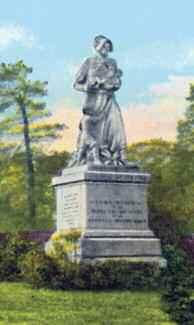
Trails Road, would follow the route of the “Old Cumberland Pike” (National Road) while incorporating several other old trails
One of the motivations for establishing National Old Trails Road was the desire to honor the spirit and fortitude of the pioneers. The DAR was among the first national organizations to commemorate “Old Trails ” The organization’s leaders promised the Road would be marked with many monuments and boulders commemorating heroes and heroic deeds
● 10 The Madonna of the Trail
The culmination of this effort was the now famous Madonna of the Trails statues. Designed by German sculptor, August Leimbach and made of cast concrete, twelve identical statues, symbolizing sturdy, hardworking pioneer women, were placed along National Old Trails Road Ohio’s statue is located just west of Pennsylvania House and was the first to be constructed It was dedicated by then Judge Harry S Truman, later President of the United States, on July 4, 1928 The statue underwent a major restoration in 2003
To visit Snyder Park and the Madonna of the Trail continue (west) on Main Street. Turn right (north) onto Bechtle Avenue, go one block then turn left (west) onto North Street North Street changes names to Park Road. Snyder Park is within one mile of Bechtle Avenue. Make a right (north) into Snyder Park Drive You must park in Snyder Park and walk across the field to view the Madonna of the Trail. She sits facing Park Road just before Buck Creek within 500 feet (west) of the entrance to the park.
● 11 George Rogers Clark Park
Daniel Hertzler House
Peckuwe Settlements Battle Site
936 South Tecumseh Road off State Route 4
The 248 acre George Rogers Clark Park includes both the Hertzler House and battle site. Recreational activities include picnicking, hiking, fishing and nonmotorized boating.
Daniel Hertzler House. The Daniel Hertzler House located in George Rogers Clark Park, was constructed in 1854, with later additions. The house is built into the side of the hill, much like Pennsylvania Bank barns of the perio d. Hertzler came to Clark County from Pennsylvania in 1840 and amassed a fortune from milling, distilling and real estate. Daniel Hertzler’s wealth may have contributed to his demise. He was murdered in the house, October 10, 1867. The crime was never solved.
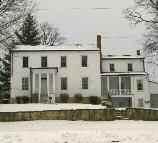
Peckuwe Settlements Battle Site.
The site is significant as the scene of the largest Revolutionary War battle west of the Allegheny Mountains The battle took place between Kentucky militia led by Colonel George Rogers Clark and the British supported by Shawnee Indians on August 8, 1780 Clark’s forces prevailed and the victory helped secure western lands for the new American nation.
Donnelsville
Donnelsville was laid out in 1832 by Captain Abram Smith. Its linear plan is typical of other Pike towns along the Road. At the east end of town, watch for the former Adobe Motel on the south side of the Road, another 1930s survivor.
38
Left: Madonna of the Trail statue, Snyder Park, Springfield, ca 1930s
Hertzler House, built by Daniel Hertzler in 1854
Auto Tourists in the Early Twentieth Century
Early “auto tourists” embraced a gypsy lifestyle, sleeping in farmer’s fields or in tents attached to their cars. Public (municipally controlled) and then private tourist camps developed in the 1910s and 1920s in response to the increasing number of overnight travelers. By the mid 1920s most camps were located on the outskirts of town with a growing number of conveniences that forecast the mid-twentieth century motel. Tourist homes were another early overnight option. Tourist homes became particularly common in the 1930s during the Great Depression when home owners welcomed overnight visitors to obtain additional income. Cabin camps were the earliest semi-permanent lodgings built to accommodate the National Road/U.S. 40 traveler. Cabins were usually one-story, one-room buildings and looked like small houses. They were usually grouped in a row or crescent arrangement to provide parking adjacent to each cabin. As cabin camps became more substantial in the 1930s the word cottage was used to describe these accommodations. Cottages were larger and more durable and were winterized for yeararound use. Each cottage contained a private bathroom and some included kitchens or kitchenettes. Cottage camps were succeeded by motor courts and motels beginning in the 1940s. Motor courts integrated all of the rooms under a continuous one-story roofline. By the early 1950s many motor courts and motels were adding coffee shops and restaurants.
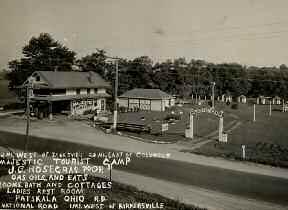

● 12 Garfield Grove
Located on the south side at 9151 West National Road are the remnants of Garfield Grove, a 1930s tourist camp that in the 1950s still included seven single cottages, three double cottages, a gas station, restaurant, and a wash house with restrooms and showers for travelers who preferred to camp outside rather than rent a cottage. Some of the cottages were later converted into apartments.
MIAMI COUNTY Brandt
Brandt was laid out along the National Road and State Route 201 in 1839 by the Voorhis brothers. Rt. 201 was one of several
known cut-offs south to Dayton, used by travelers to avoid the poor condition of the National Road.
● 13 Phoneton
Originally platted as Phonetown, this Miami County community was established by the American Telephone & Telegraph Company in 1893. It was the intersection of three major long-line telephone and telegraph lines. AT&T employed up to forty operators at its repeater station located here. The company built a twenty-six room hotel and boarding house for employees and bussed others from nearby communities. The site was abandoned in 1936 and most of the operation was moved to Dayton
MONTGOMERY COUNTY
Vandalia Vicinity
West of Phoneton the Road crosses the Taylorsville Dam, the first of two Miami Conservancy District dams, constructed in response to the great flood of 1913 The flood inundated large portions of Dayton and many other communities in the Miami River valley. The dam was quite an engineering feat at the time of its construction. It is 3000 feet long and 415 feet wide at its base, and capable of carrying U.S. 40 across its top.
● 14 Taylorsville MetroPark
The Dayton area ’ s park district is called the Five Rivers MetroParks. Two of the system’s
39
Top right: The Majestic Tourist Camp at the northeast corner of the National Road and York Road, one mile west of Kirkersville, 1930s. Middle right: Tourist cabins, Bohn Road and U.S. 40, just west of Euphemia/Lewisburg in Preble County.
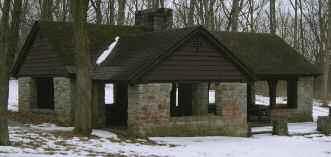
Vandalia
After crossing Taylorsville Dam, the Road makes a sharp right and then a left and crosses Interstate 75 and the old Dixie Highway (U.S. 25) before entering Vandalia. Vandalia was platted in 1838 by Benjamin Wilhelm, the first merchant and postman, and named for the National Road’s eventual destination, Vandalia, Illinois. Today, most of Vandalia’s early roadscape has been replaced by a modern, auto-oriented commercial strip.
● 17 Aullwood Audubon Center and Farm Aullwood House and Garden
parks lie directly on the National Road. Taylorsville MetroPark contains 1302 acres along the Great Miami River and is the habitat of the State Champion Shumard Oak Tree. The park has 13 miles of hiking trails which includes the Great Miami River Recreational Trail and part of the Buckeye Trail, a 1200-mile long trail that traverses the state.
● 15 The Ruins of Tadmor
Accessible from Taylorsville MetroPark, along the Great Miami River Recreational Trail, are the ruins of Tadmor. Tadmor was strategically located at a point where the National Road crossed the Great Miami River, the Miami and Erie Canal and the
Dayton and Michigan Railroad. It was hoped that this strategic location would help Tadmor grow and prosper, but successive floods stifled growth and Tadmor was finally abandoned when the Miami Conservancy District dam was constructed in the 1920s.
● 16 Early Twentieth Century Road Bed
Also accessible from Taylorsville MetroPark is an early twentieth century modification of the National Road. This Road cut from the Great Miami River valley to Vandalia was constructed between 1906 and 1909, through seventeen feet of limestone reducing the grade to less than seven percent and eliminating an earlier series of switchbacks.

The Aullwood Audubon Center and Farm are located just south of U.S. 40 at the east end of the Englewood Dam on land donated to Five Rivers MetroPark by environmentalist Marie Aull. The Center’s 350 acres include a visitor center and environmental center, a working farm and five miles of trails through prairie, meadow, woodland and wetland environments. Nearby is the 32 acre Aull estate with its Arts and Craft house and shade garden.
Below: (left) This view of Tadmor shows the covered bridge carrying the National Road across the Great Miami River with the town post office and general store and canal tow path in the foreground. (right) Early 20th century Road modification near Vandalia, ca. 1910.
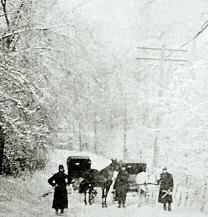
40
This picnic shelter at Taylorsville MetroPark was constructed by the Civilian Conservation Corps (CCC) in 1938 and restored by the CCC in 1989
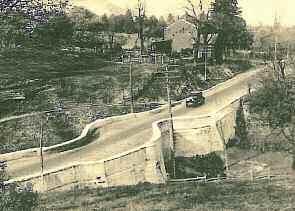
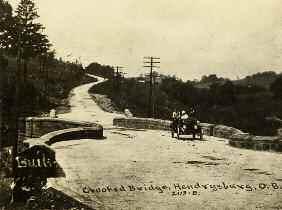
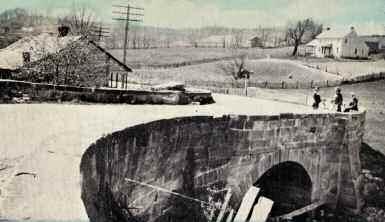

S Stands for Bridge
S-bridges are a unique feature of the National Road. Folklore abounds as to why they were built. One story suggests the s-shape forced drivers to slow their horses, reducing the chance of accidents. Some said the bridges were originally built around huge trees, while others claimed they were the result of inebriated bridge builders. However, there is a logical explanation for Ohio’s crooked bridges. The National Road seldom encountered streams and rivers at a direct 90-degree angle. In order for bridges to be constructed so as to cross these bodies of water at 90 degrees while maintaining the direction and location of the Road, an S-shaped design was selected as the solution. The S-shape easily accommodated slow-moving droves of animals and horse and oxen-drawn wagons, but with the advent of higher-speed automobile traffic they became a hazard. Most were soon bypassed, although at least one — near Hendrysburg — was straightened in 1933 and continued in use for several more years.
Top: (left) Hendrysburg S-bridge looking east. Clark House on left (see page 14).
(right) S-bridge at Hendrysburg, looking west, straightened in 1933
Middle: Old National Road bridge, Bridgewater, Ohio, demolished. Notice toll house on left.
41
Bottom: S-bridge west of Middlebourne showing the alignment of original Road (on left) crossing the bridge, U.S. 40 at upper right.
